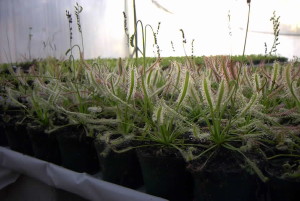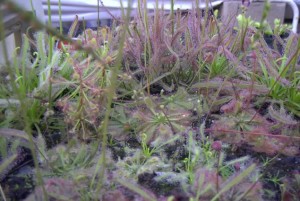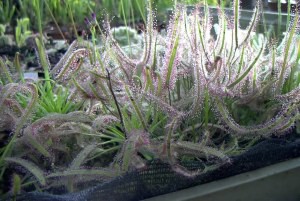The beauty and variety of the 100 or so Drosera varieties (Sundews) could well overshadow their unique adaptation to carnivorism. Sundews got their name from the unique dew-like droplets that are found sparkling in the sunlight on the ends of their “tentacles”. Sundews occur in all parts of the world, but mostly in Australia, America and New Zealand. South Africa also has 18 species, which are indigenous to the western Cape. Sundews are generally small plants growing in flat rosettes up to 100 mm in size but there are some giant species forming leaves over 40 cm long. They are found in wetlands, alongside streams and in marshes. Their leaf shapes range from slender threads to broad paddles to elaborate sprays resembling deer antlers. The leaves bear tentacles that radiate in all directions, each bearing a gland that secretes droplets of mucilage, giving the plant its dewy appearance. Insects are attracted by the look and smell of the leaves and become mired in the sticky “dew”. The struggling victim stimulates the tentacles to bend and touch it, drawing it closer to the leaf. At the same time glands in the leaf secrete powerful digestive enzymes and acids in anticipation of dinner. When compared with other carnivorous plants, Sundews extract nutrients from the insect very quickly, taking from 24 to 48 hours. When finished, the tentacles release the carcass, ready for another meal. Sundews can easily be kept in a potting mixture similar to that used for the Venus Fly Traps. They can be grown outdoors, even in full sun, as long as the medium in which they are growing is kept moist.


